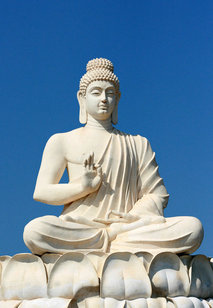Buddhism is a religion based on the teachings of Siddharta Gotama, who became known as Buddha after his “enlightening”. Siddharta Gotama was born into a royal family, in what is now known as Nepal, in 563 BC.¹ He realized at age 29 that wealth and luxury did not guarantee happiness, and spent the next 6 years studying and meditating until he found “the middle path”. Buddhism is practiced by approximately 300 million people around the world.¹
Buddhism envelops a way of life that encourages its followers to lead a morale life, to be mindful and aware of thoughts and actions, and to develop wisdom and understanding. Buddhism is summarized by its Four Noble Truths, the Noble Eightfold Path, and The Five Main Precepts.¹
The Four Noble Truths¹:
- The first truth is that life is suffering
- The second truth is that suffering is caused by craving and aversion
- The third truth is that suffering can be overcome and happiness can be attained
- The fourth truth is that the Noble Eight-Fold Path is the path that leads to the end of suffering
The Noble Eight-Fold Path¹:
The Noble Eight-fold Path is being moral, focussing the mind on being fully aware of thoughts and actions, and developing wisdom by understanding the Four Noble Truths and by developing compassion for others.¹
The Five Main Precepts¹:
- Do not take the life of anything living
- Do not take anything not freely given
- To abstain from sexual misconduct and sensual overindulgence
- To refrain from untrue speech
- To avoid intoxication and losing mindfulness
Image source:
1. Wikimedia
Reference:
1. Buddhanet. (n.d.) Buddhist Studies: A Five Minute Introduction. Retrieved from http://www.buddhanet.net/e-learning/5minbud.htm
